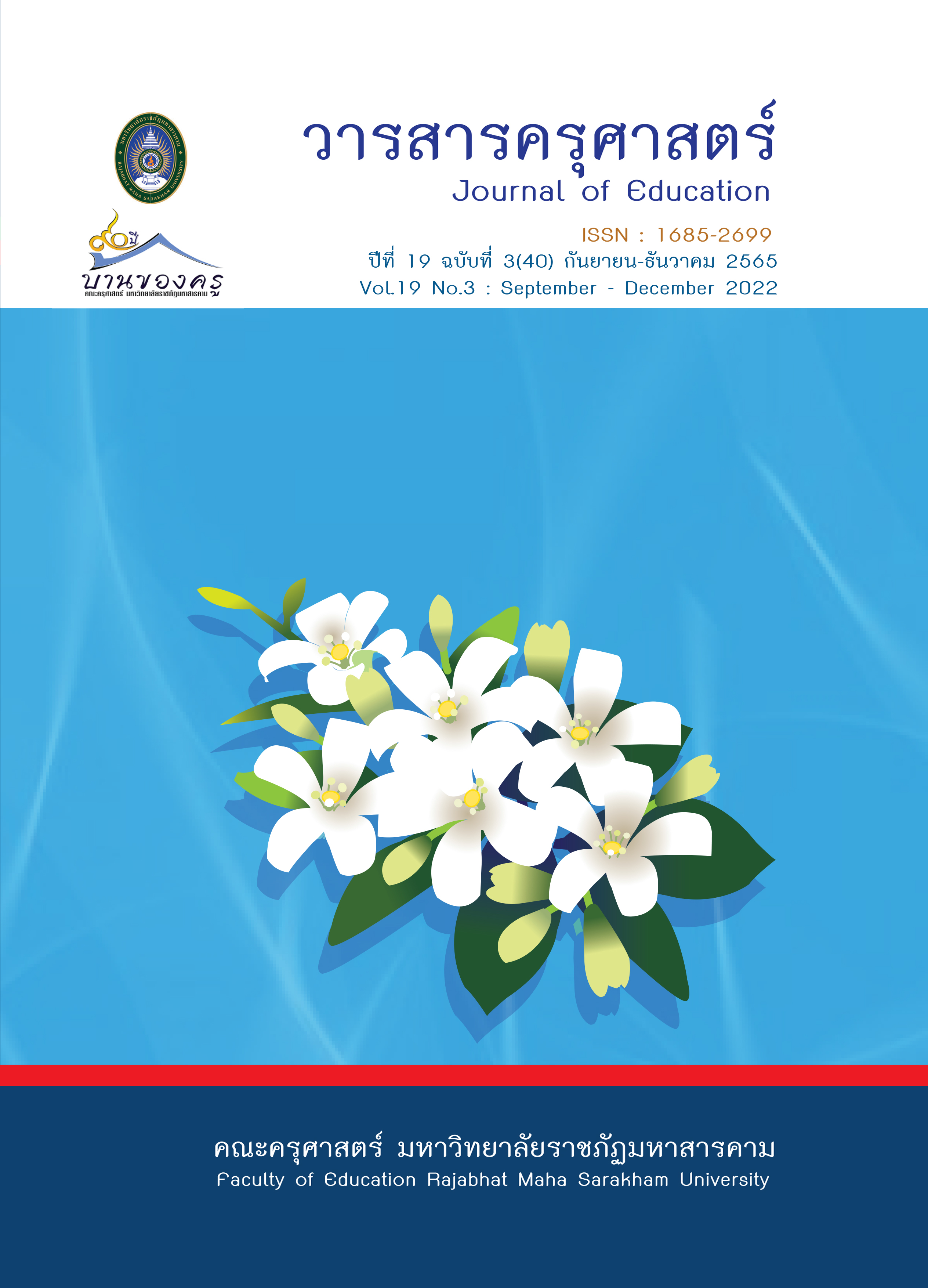Musical Problem-Solving Process in Collaborative Learning of Second Year Students, Majoring in Western Music, Bachelor Degree in Music Program, Khon Kaen University
Main Article Content
Abstract
The objective of the research was to study the musical problem-solving process in collaborative learning activities of western music major students, Bachelor degree in Music program, Faculty of Fine and Applied Arts, Khon Kaen University. This research was a qualitative. By study the result of the learning model with 8 students. The research concept tools which the problem solving process were 1) learning activities, 2) worksheets, 3) field survey form, and 4) post-learning activities observation form and the videos, including the data collecting from videos for problem solving protocols and protocols analysis. The concept of the problem-solving process consisted of four stages: Stage 1; understanding the problems, Stage 2; planning, Stage 3; problem-solving implementation, and stage 4; doing verification .
The research results showed that there were 6 activities for musical problem-solving processes.
The sample earned the discussing problem solving process skill in the 1-3 learning activities which this result observation. According to the 4-6 learning activities, there were 4 steps they had earned: the first steps of the processes which result was from their discussion observation, teachers interview, music exercises, and music rehearsal. The second step: the song movement responsibility, the third step: students’ rehearsals and their performances, and the fourth step: their discussion after their performances on the stage.
Article Details

This work is licensed under a Creative Commons Attribution-NonCommercial-NoDerivatives 4.0 International License.
ข้อกำหนดเบื้องต้นที่ผู้นิพนธ์(ผู้ส่งบทความ) ควรทราบ
1. ผู้นิพนธ์ที่ประสงค์จะลงตีพิมพ์บทความกับวารสาร ตั้งแต่เดือนมกราคม 2563 เป็นต้นไป ให้ใช้รูปแบบใหม่ (Template 2563) โดยสามารถดูตัวอย่างได้ที่เมนู GUIDELINES
2. จะตีพิมพ์และเผยแพร่ได้ ต้องผ่านการประเมินจากผู้ทรงคุณวุฒิ (Peer Review)
3. การประเมินบทความโดยผู้ทรงคุณวุฒิ (Peer Review) เป็นแบบ Double Blind
4. การอ้างอิงบทความใช้หลักเกณฑ์ APA (American Psychological Association) คลิก
5. บทความถูกปฏิเสธการตีพิมพ์ ไม่ผ่านการประเมิน ผู้นิพนธ์ขอยกเลิกเองหรือชำระเงินก่อนได้รับการอนุมัติ ทางวารสารไม่มีนโยบายการคืนเงิน
References
เก่งกิจ กิติเรียงลาภ. (2562). เขียนชนบทให้เป็นชาติ กำเนิดมานุษยวิทยาไทยในสงครามเย็น. สำนักพิมพ์มติชน.
กวิสรา สันเสนาะ และไมตรี อินทร์ประสิทธิ์. (2550). ศึกษายุทธวิธีเกี่ยวกับความตระหนักในการคิดในกระบวนการแก้ปัญหาปลายเปิด. วารสารวิจัย มข, 7(1), 156-163.
กรมวิชาการ. (2544). เทคนิคการจัดการเรียนรู้ที่ผู้เรียนสำคัญที่สุดในการจัดการเรียนรู้แบบร่วมมือ. การศาสนา.
คณะศิลปกรรมศาสตร์. (2560). คู่มือนักศึกษาคณะศิลปกรรมศาสตร์ ประจำปีการศึกษา 2560. มหาวิทยาลัยขอนแก่น.
จุไรรัตน์ แสนใจรักษ์. (2547). ปฏิรูปการศึกษา. สถาบันวิถีทรรศน์.
ณรุทธ์ สุทธจิตต์. (2560). วิธีวิทยาการสอนดนตรี. จุฬาลงกรณ์มหาวิทยาลัย.
ประทินรัตน์ นิยมสิน. (2554) การศึกษาปฏิสัมพันธ์ระหว่างการจัดการเรียนรู้แบบร่วมมือเทคนิค TAI และเทคนิค TGT กับระดับความสามารถทางการเรียนที่มีผลต่อผลสัมฤทธิ์ทางการเรียนคณิตศาสตร์และทักษะการเชื่อมโยงทางคณิตศาสตร์ของนักเรียน [วิทยานิพนธ์ปริญญามหาบัณฑิต]. มหาวิทยาลัยพระนครศรีอยุธยา.
มหาวิทยาลัยขอนแก่น. (2562). แผนยุทธศาสตร์การบริหาร มหาวิทยาลัยขอนแก่น พ.ศ. 2563-2566. มหาวิทยาลัยขอนแก่น.
ยศวดี บุณยเกียรติ. (2547). ปฏิรูปการศึกษาให้ “คิดเป็น-ทำเป็น”. สถาบันวิถีทรรศน์.
Barell, J. (2010). Problem-Based Learning: The Foundation for 21st Century Skills. In James Bellanca & Ron Brandt (Eds.), 21st century skills: rethinking how students learn. Solution Tree Press.
Darling-Hammond, L. (2010). New Policies for 21st Century Demands. In James Bellanca & Ron Brandt (Eds.), 21st century skills: rethinking how students learn. Solution Tree Press.
Dede, C. (2010). Comparing Frameworks for 21st Century Skills. In James Bellanca & Ron Brandt (Eds). 21st century skills: rethinking how students learn. Solution Tree Press.
Fogarty, R. & Pete, B. M. (2010). The Singapore Vision: Teach Less, Learn More. In James Bellanca & Ron Brandt (Eds.), 21st century skills: rethinking how students learn. Solution Tree Press.
Harrington, W.J. (2016). Collaborative Learning among high school students in a chamber music setting. Britol: Department of Music, Bristol Doctoral College, The University of Britol.
James, J. (2019). Crossing the Divide: the 'Reinvention Method' for Creative Collaborative Learning in Pairs Between Advanced Classical and Jazz Students. Boston: College of Fine Arts, Boston University.
Johnson, D. W. & Johnson, R. T. (2010). Cooperative Learning and Conflict Resolution: Essential 21st Century Skills. In James Bellanca & Ron Brandt (Eds.), 21st century skills: rethinking how students learn. (pp. 201-219). Solution Tree Press.
Kay, K. (2010). 21st Century Skills: Why They Matter, What They Are, and How We Get There. In James Bellanca & Ron Brandt (Eds.), 21st century skills: rethinking how students learn. (pp xiii-xxviii). Solution Tree Press.
LeBlance, J. F. (1977). You can teach problem solving. Arithmetic Teacher. 25 :16- 20.
Luke, D.W. (2001). Collaborative Learning in music therapy education as experienced in a course in the foundation and principles of music therapy. USA: College of Fine Arts, Michigan State University.
Polya, G. (1945). How to solve it. Princenton University.
Russell, J. (1997, March). The Mediating Function of Language in the Formation of Musical Knowledge, Musical Concepts and Musical Problem-Solving in Instructional Settings. [Paper presentation]. The Annual Meeting of the American Educational Research Association, McGill University.
Slette, A. L. (2018). Negotiating Musical Problem-Solving in Ensemble Rehearsals. British Journal of Music Education, 36(1), 1-15. https://www.researchgate.net/publication/327290292_Negotiating_ musical_problem- solving_in_ensemble_rehearsals


